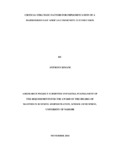| dc.description.abstract | The East African Countries are currently implementing the Common Market phase of integration which should have fully implemented the Common Union by July 2010. The protocol establishing the CU provided for implementation of several instruments some of which are still outstanding. The purpose of the study was to identify critical strategies for successful implementation of harmonized East African Community (EAC) Customs union. The following critical strategies were to assessed: Common External Tariff on goods outside EAC region, intra-trade border custom procedures, multiple memberships to regional blocks among EAC members; application uniform rules of origin on EAC produced products and movement or flow of factor of production across the EAC Partner States. The study adopted a descriptive research design. The design was used to describe the current status of implementation of Customs Union under EAC as well the challenges facing implementation. The target population was 31 administrators and managers, drawn from Ministry of East African Community, Ministry of Trade, Ministry of Finance and Kenya Revenue Authority. Using purposive sampling, a sample size of 31 was drawn from the target population. All the target respondents were covered hence the study achieved 100% response rate. The study used primary data collected using a questionnaire that was administered using structured interviews. Descriptive statistics were used to analysis the data which was presented using the tables and graphs. The study revealed that the implementation of the EAC CU Protocol has been delayed and is not on schedule. The implementation process has experienced both successes and challenges since the inception of CU in 2005. Among the successes that were cited by the respondents include complete harmonization of the tariff codes; simplification and harmonization of trade documents and procedures; establishment of East African bill of entry; development of the rules of origin; and sharing of information among partner states. The respondents indicated that implementation of Custom union will increase intra-EAC trade. Other benefits cited by respondents that are associated implementation of harmonized CU include free movement of people, increase in volume of trade and investment, and increase in employment. The study revealed that certain areas of the CU Protocol continue to pose challenges, however, including introduction of Common External Tariff, particularly the harmonization of rates and exemptions; Elimination of Non-Tariff Barriers; and Application of rules of origin. Unlike elimination of internal tariffs, adoption of a CET is a challenge and has significant revenue implications to Kenya, according to the personnel interviewed. With respect to implementation of the CET, majority of respondents reported that the major difficulty being experienced was reaching consensus on a common external tariff (CET). Other difficulties cited by respondent each are delays due to mistrust, indecision on tariffs, and creation of new documents. Moreover, membership to multiple integration schemes, perceived or real differences in development levels among the countries, and suspicion were reported as the key obstacles to the speedy implementation of the EACCU. In order to maximize the benefits associated with implementation of harmonized CU, the following critical strategies were recommended: non-tariff hindrances should be removed, pace of tariff elimination accelerated, and involvement of private sector increased. However, respondent cited loss of revenue as main concern of implementation of CU. To mitigate loss of revenue associated with harmonized custom union the respondents felt that the EAC countries need to adopt a Common External Tariff, hasten the integration process, and reduce membership in multiple regional groupings. | en_US |



